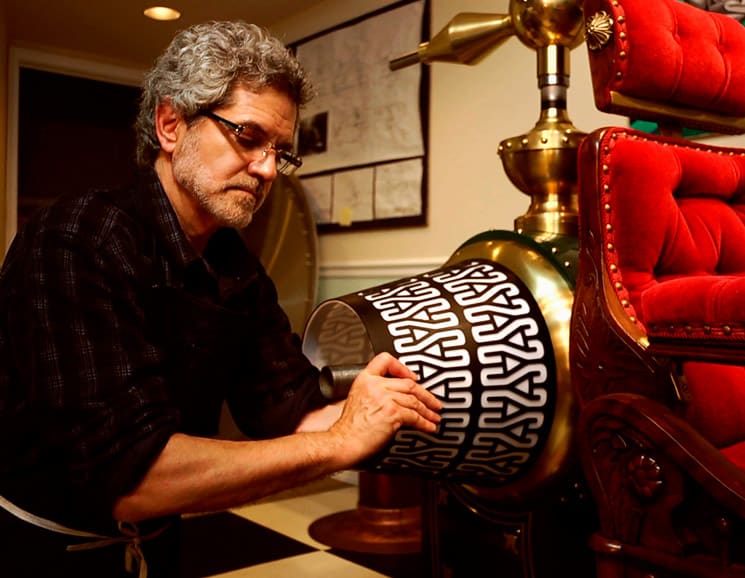In Jay Cheel's absorbing and frequently amusing documentary How to Build a Time Machine, Ron Mallett and Robert Niosi are two men going about the same process in very different ways. Mallett is a physicist who's spent his career trying to devise a formula and build an apparatus that will create a portal to the past, while Niosi is a stop-motion animator who has poured years into building a replica of the titular prop featured in the 1960 film The Time Machine.
Aside from the obvious implications of a scientific breakthrough, Mallett's motives are largely sentimental. He lost his father at a young age to a heart attack and has long fantasized about having the opportunity to go back in time and warn his father of his health condition. Of course, Mallett also recognizes the paradox this scenario would create, as saving his father's life would likely mean that his interest in the field would have never led him to create a time machine in the first place.
Some of the most intriguing moments of the film come from watching Mallett demonstrate how a practical time machine could actually work. Using a coffee bean that's being stirred in a cup of coffee as an example, he explains how lasers act as a veritable whirlpool to help manipulate time back and forth. It's hardly the easiest concept for the uninitiated to grasp, and it remains to be seen how successful his experiments have been with his machine, but just being privy to these kinds of explorations of time leave you with a sense of wonder.
Niosi's pursuits, meanwhile, are purely aesthetic. What started out as a fun little project that was meant to only take a few months grew to consume him for more than a decade. He's pored over the film obsessively to glean every last detail, and consulted with a community of people who are also devoted to lovingly re-creating the same time machine. He wisely declines at one point to answer how much money he's dumped into the project, so we're left to only guess at how astronomical that figure must be simply from gazing on the costly materials involved.
It's all enough to make you wish that perhaps more time had been spent with Mallett learning the ins and outs of how his machine and the science behind it function than with Niosi's increasingly indulgent exploits. It's not that Niosi's efforts are without merit — after all, the former Pee Wee's Playhouse artist devoted years just to learning different trades that would then help him in the construction — but it's difficult to get as invested in even the most elaborate of props when it's ultimately just going to end up as just another impressive decoration in his elaborately designed home.
But as Niosi suggests, film itself is its own form of time travel, preserving moments for eternity that we can return to whenever we like. So while he may not be able to travel through time with what he's crafted, he can always revisit the painstaking process he undertook simply by watching this documentary. Unfortunately, he'll still never be able to get back all of that time he spent making it.
(Films We Like)Aside from the obvious implications of a scientific breakthrough, Mallett's motives are largely sentimental. He lost his father at a young age to a heart attack and has long fantasized about having the opportunity to go back in time and warn his father of his health condition. Of course, Mallett also recognizes the paradox this scenario would create, as saving his father's life would likely mean that his interest in the field would have never led him to create a time machine in the first place.
Some of the most intriguing moments of the film come from watching Mallett demonstrate how a practical time machine could actually work. Using a coffee bean that's being stirred in a cup of coffee as an example, he explains how lasers act as a veritable whirlpool to help manipulate time back and forth. It's hardly the easiest concept for the uninitiated to grasp, and it remains to be seen how successful his experiments have been with his machine, but just being privy to these kinds of explorations of time leave you with a sense of wonder.
Niosi's pursuits, meanwhile, are purely aesthetic. What started out as a fun little project that was meant to only take a few months grew to consume him for more than a decade. He's pored over the film obsessively to glean every last detail, and consulted with a community of people who are also devoted to lovingly re-creating the same time machine. He wisely declines at one point to answer how much money he's dumped into the project, so we're left to only guess at how astronomical that figure must be simply from gazing on the costly materials involved.
It's all enough to make you wish that perhaps more time had been spent with Mallett learning the ins and outs of how his machine and the science behind it function than with Niosi's increasingly indulgent exploits. It's not that Niosi's efforts are without merit — after all, the former Pee Wee's Playhouse artist devoted years just to learning different trades that would then help him in the construction — but it's difficult to get as invested in even the most elaborate of props when it's ultimately just going to end up as just another impressive decoration in his elaborately designed home.
But as Niosi suggests, film itself is its own form of time travel, preserving moments for eternity that we can return to whenever we like. So while he may not be able to travel through time with what he's crafted, he can always revisit the painstaking process he undertook simply by watching this documentary. Unfortunately, he'll still never be able to get back all of that time he spent making it.




